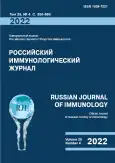HBD1 and LL37 gene expression in children with atopic dermatitis
- 作者: Bystritskaya E.P.1, Murashkin N.N.2,3, Materikin A.I.2, Naumova E.A.4, Yakovleva I.V.1, Vartanova N.O.1, Svitich O.A.1,3
-
隶属关系:
- I. Mechnikov Research Institute for Vaccines and Sera
- Medical Research Center for Children’s Health
- I. Sechenov First Moscow State Medical University of the Ministry of Health of the Russian Federation (Sechenov University)
- M. Lomonosov Moscow State University
- 期: 卷 25, 编号 4 (2022)
- 页面: 405-410
- 栏目: SHORT COMMUNICATIONS
- URL: https://journals.rcsi.science/1028-7221/article/view/120056
- DOI: https://doi.org/10.46235/1028-7221-1194-HAL
- ID: 120056
如何引用文章
全文:
详细
Atopic dermatitis (AD) is a multifactorial genetically determined inflammatory skin disease characterized by itching, chronic course, age-related features of localization and lesion morphology. Atopic dermatitis is caused by complex interactions between genetic, immunological, and environmental factors. The barrier function of the skin is impaired in atopic dermatitis. Antimicrobial peptides, e.g., LL-37, b-defensins are involved in maintaining the skin barrier function (especially, intercellular contacts). An imbalance of antimicrobial peptides may cause different disorders, including allergic pathologies. The aim of this study is to investigate gene expression profile of the HBD1 and LL37 encoding antimicrobial peptides in the samples of skin and blood mononuclear cells obtained from the children with moderate and severe atopic dermatitis before and after treatment. By means of real-time polymerase chain reaction, the levels of HBD1 and LL37 gene expression were evaluated in the samples. Statistical analysis showed significantly increased (p ≤ 0.017) expression levels of both HBD1 (H-test = 24.76; 2, n = 72; p = 0.00001), and LL37 genes (H-test = 15.69; 2, n = 72; p = 0.00039) in blood cells of AD patients compared to the control group, as well as decreased (p ≤ 0.05) levels of HBD1 expression in the affected skin compared to the control group. Our data on the cathelicidin gene in the skin do not differ from the literature data, since its expression is reduced in AD. In our series, an increase of the gene expression was revealed in PBMCs. The HBD1 peptide is expressed in both monocytes and macrophages, representing a link between innate and adaptive immunity. In our study, the expression of the HBD1 gene was increased only in blood, thus suggesting activation of innate immunity components at the systemic level in response to inflammation. Of importance, understanding the role of immunological markers in AD will help to develop novel prognostic approaches in management of the patients with atopic disorders. Therefore, one should understand pathogenetic mechanisms of allergic diseases.
作者简介
E. Bystritskaya
I. Mechnikov Research Institute for Vaccines and Sera
编辑信件的主要联系方式.
Email: lisabystritskaya@gmail.com
Postgraduate Student, Junior Research Associate, Laboratory of Molecular Immunology
俄罗斯联邦, MoscowN. Murashkin
Medical Research Center for Children’s Health; I. Sechenov First Moscow State Medical University of the Ministry of Health of the Russian Federation (Sechenov University)
Email: lisabystritskaya@gmail.com
PhD, MD (Medicine), Professor, Senior Research Associate, Head, Department of Dermatology, Head, Laboratory of Skin Pathology in Children; Professor
俄罗斯联邦, Moscow; MoscowAlexander Materikin
Medical Research Center for Children’s Health
Email: lisabystritskaya@gmail.com
PhD (Medicine), Dermatovenereologist, Department of Dermatology
俄罗斯联邦, MoscowE. Naumova
M. Lomonosov Moscow State University
Email: lisabystritskaya@gmail.com
Research Associate, Department of Genetics, Faculty of Biology
俄罗斯联邦, MoscowI. Yakovleva
I. Mechnikov Research Institute for Vaccines and Sera
Email: lisabystritskaya@gmail.com
PhD (Biology), Research Associate, Laboratory of Cells Hybridomas
俄罗斯联邦, MoscowN. Vartanova
I. Mechnikov Research Institute for Vaccines and Sera
Email: lisabystritskaya@gmail.com
PhD (Biology), Senior Research Associate, Laboratory of Microbiology of Opportunistic Bacteria
俄罗斯联邦, MoscowOxana Svitich
I. Mechnikov Research Institute for Vaccines and Sera; I. Sechenov First Moscow State Medical University of the Ministry of Health of the Russian Federation (Sechenov University)
Email: lisabystritskaya@gmail.com
PhD, MD (Medicine), Corresponding Member, Russian Academy of Sciences, Head, Laboratory of Molecular Immunology, Director; Professor, Department of Microbiology, Virology and Immunology
俄罗斯联邦, Moscow; Moscow参考
- Мурашкин Н.Н., Амбарчян Э.Т., Материкин А.И., Епишев Р.В. Роль нарушений эпидермального барьера при атопическом дерматите: современные концепции патогенеза заболевания // Вопросы современной педиатрии, 2018. Т. 17, № 1. С. 85-88. [Murashkin N.N., Ambarchian E.T., Materikin A.I., Epishev R.V. The role of epidermal barrier impairments in atopic dermatitis: modern concepts of disease pathogenesis. Voprosy sovremennoy pediatrii = Current Pediatrics, 2018, Vol. 17, no. 1, pp. 85-88. (In Russ.)]
- Свитич О.А., Ганковская Л.В., Рахманова И.В., Зайцева И.А., Ганковский В.А. Ассоциация полиморфных маркеров, локализованных в 5’-нетранслируемой области гена Defb 1, с гипертрофией аденоидных вегетаций // Вестник Российского государственного медицинского университета, 2012. T. 3. C. 59-62. [Svitich O.A., Gankovskaya L.V., Rakhmanova I.V., Zaytseva I.A., Gankovskiy V.A. The association of polymorphic markers in the 5`-untranslated region of the DEFB1 gene with adenoid hypertrophy vegetations. Vestnik Rossiyskogo gosudarstvennogo meditsinskogo universiteta = Bulletin of Russian State Medical University, 2012, Vol. 3, pp. 59-62. (In Russ.)]
- Alexandre-Ramos D.S., Silva-Carvalho A.É., Lacerda M.G., Serejo T.R.T., Franco O.L., Pereira R.W., Carvalho J.L., Neves F., Saldanha-Araujo F. LL-37 treatment on human peripheral blood mononuclear cells modulates immune response and promotes regulatory T-cells generation. Biomed. Pharmacother., 2018, Vol. 108, pp. 1584-1590.
- Chieosilapatham P., Ogawa H., Niyonsaba F. Current insights into the role of human β-defensins in atopic dermatitis. Clin. Exp. Immunol., 2017, Vol. 190, no. 2, pp. 155-166.
- Kovalchuk L.V., Gankovskaya L.V., Gankovskaya O.A., Lavrov V.F. Herpes simplex virus: treatment with antimicrobial peptides. Adv. Exp. Med. Biol., 2007, no. 601, pp. 369-376.
- Luger T., Adaskevich U., Anfilova M., Dou X., Murashkin N.N., Namazova-Baranova L., et al. Practical algorithm to inform clinical decision-making in the topical treatment of atopic dermatitis. J. Dermatol., 2021, Vol. 48, no. 8, pp. 1139-1148.
- Reinholz M., Ruzicka T., Schauber J. Cathelicidin LL-37: An Antimicrobial Peptide with a Role in Inflammatory Skin Disease. Ann. Dermatol., 2012, Vol. 24, no. 2, 126. doi: 10.5021/ad.2012.24.2.126.
- Weidinger S., Beck L.A., Bieber T., Kabashima K., Irvine A.D. Atopic dermatitis. Nat. Rev. Dis. Primers, 2018, Vol. 4, 1. doi: 10.1038/s41572-018-0001-z.
补充文件







